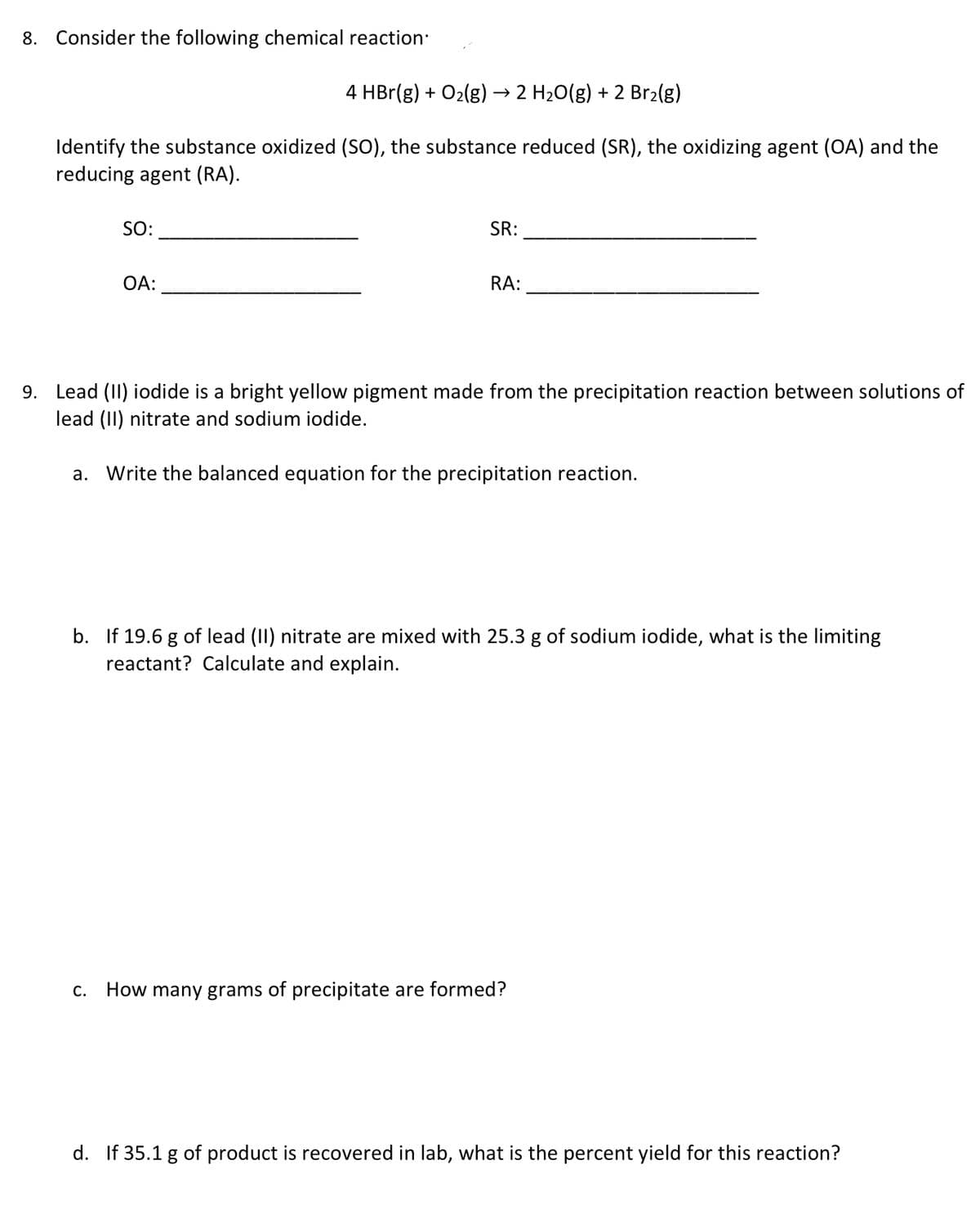8. Consider the following chemical reaction: 4 HBr(g) + O2(g) → 2 H20(g) + 2 Br2(g) Identify the substance oxidized (SO), the substance reduced (SR), the oxidizing agent (OA) and the reducing agent (RA). SO: SR: OA: RA: 9. Lead (II) iodide is a bright yellow pigment made from the precipitation reaction between solutions of lead (II) nitrate and sodium iodide. a. Write the balanced equation for the precipitation reaction. b. If 19.6 g of lead (II) nitrate are mixed with 25.3 g of sodium iodide, what is the limiting reactant? Calculate and explain. с. How many grams of precipitate are formed?
8. Consider the following chemical reaction: 4 HBr(g) + O2(g) → 2 H20(g) + 2 Br2(g) Identify the substance oxidized (SO), the substance reduced (SR), the oxidizing agent (OA) and the reducing agent (RA). SO: SR: OA: RA: 9. Lead (II) iodide is a bright yellow pigment made from the precipitation reaction between solutions of lead (II) nitrate and sodium iodide. a. Write the balanced equation for the precipitation reaction. b. If 19.6 g of lead (II) nitrate are mixed with 25.3 g of sodium iodide, what is the limiting reactant? Calculate and explain. с. How many grams of precipitate are formed?
Chemistry: Principles and Practice
3rd Edition
ISBN:9780534420123
Author:Daniel L. Reger, Scott R. Goode, David W. Ball, Edward Mercer
Publisher:Daniel L. Reger, Scott R. Goode, David W. Ball, Edward Mercer
Chapter3: Equation, The Mole, And Chemical Formulas
Section: Chapter Questions
Problem 3.49QE:
One of the ways to remove nitrogen monoxide gas, a serious source of air pollution, from smokestack...
Related questions
Question
100%

Transcribed Image Text:8.
Consider the following chemical reaction:
4 HBr(g) + O2(g) → 2 H2O(g) + 2 Br2(g)
Identify the substance oxidized (SO), the substance reduced (SR), the oxidizing agent (OA) and the
reducing agent (RA).
SO:
SR:
OA:
RA:
9. Lead (II) iodide is a bright yellow pigment made from the precipitation reaction between solutions of
lead (II) nitrate and sodium iodide.
a. Write the balanced equation for the precipitation reaction.
b. If 19.6 g of lead (II) nitrate are mixed with 25.3 g of sodium iodide, what is the limiting
reactant? Calculate and explain.
С.
How many grams of precipitate are formed?
d. If 35.1 g of product is recovered in lab, what is the percent yield for this reaction?
Expert Solution
This question has been solved!
Explore an expertly crafted, step-by-step solution for a thorough understanding of key concepts.
Step by step
Solved in 5 steps with 7 images

Knowledge Booster
Learn more about
Need a deep-dive on the concept behind this application? Look no further. Learn more about this topic, chemistry and related others by exploring similar questions and additional content below.Recommended textbooks for you

Chemistry: Principles and Practice
Chemistry
ISBN:
9780534420123
Author:
Daniel L. Reger, Scott R. Goode, David W. Ball, Edward Mercer
Publisher:
Cengage Learning

Chemistry for Engineering Students
Chemistry
ISBN:
9781337398909
Author:
Lawrence S. Brown, Tom Holme
Publisher:
Cengage Learning

Chemistry: The Molecular Science
Chemistry
ISBN:
9781285199047
Author:
John W. Moore, Conrad L. Stanitski
Publisher:
Cengage Learning

Chemistry: Principles and Practice
Chemistry
ISBN:
9780534420123
Author:
Daniel L. Reger, Scott R. Goode, David W. Ball, Edward Mercer
Publisher:
Cengage Learning

Chemistry for Engineering Students
Chemistry
ISBN:
9781337398909
Author:
Lawrence S. Brown, Tom Holme
Publisher:
Cengage Learning

Chemistry: The Molecular Science
Chemistry
ISBN:
9781285199047
Author:
John W. Moore, Conrad L. Stanitski
Publisher:
Cengage Learning


Chemistry: An Atoms First Approach
Chemistry
ISBN:
9781305079243
Author:
Steven S. Zumdahl, Susan A. Zumdahl
Publisher:
Cengage Learning

Chemistry
Chemistry
ISBN:
9781305957404
Author:
Steven S. Zumdahl, Susan A. Zumdahl, Donald J. DeCoste
Publisher:
Cengage Learning